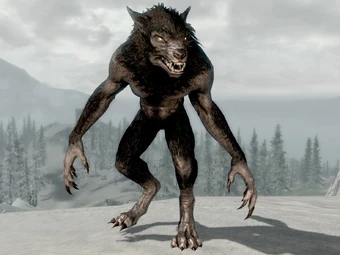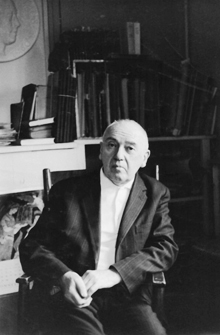Killer: Gilles Garnier
Epithet: “The Werewolf of Dole”, also “The Hermit of St. Bonnot”
Type: Lust
Nationality: French
Hunting ground(s): Dole, Franche-Comté province
Years active: 1572 - 1574
Weapon(s) used: Hands, teeth
Signature (if any):
Victims: 6 (though the account says he confessed to 4, I count 6 in all)
Survivors: None
Caught by: Villagers
Fate: Burned at the stake
A hermit living in the town of Dole in France, Garnier (sorry, I have to say it: you’re worth it!) got married and found that it was more difficult to procure food for two than one. He said that he met a spirit in a wood one night who gave him the power to change into a werewolf. After this he attacked, ate and killed up to six children from the ages of 9 to 12. He would also tear off flesh or body parts to bring home to his wife. Whether she was aware of where the meat came from, or indeed whether she ate it, is not recorded, nor are even the most minimal details about her.
Some villagers saw him with a child’s body in his arms as they made their way home from the fields one evening, and Garnier was arrested. Again, no details as to whether he was tortured, confessed or made any plea, but he was burned at the stake for the crime of lycanthropy. Whether that included, overrode or ignored murder and cannibalism I don’t know.
 Killer:
Killer: Countess Elizabeth Bathory de Ecsed
Epithet: “The Blood Countess” and “Countess Dracula”
Type: Lust
Nationality: Hungarian
Hunting ground(s): Castle of Csejte
Years active: 1585 - 1610
Weapon(s) used: Various
Signature (if any): Torture, mutilation etc
Victims: Anything from 80 to 650
Survivors: About 300
Caught by: Thurzó, Palatine of Hungary
Fate: Imprisoned in her castle until her death in 1614
Having been born into wealth and power, Countess Bathory’s many alleged torture and killings don’t appear to have a cause, other than she was rich and powerful. It may have been her upbringing, but of course there would have to have been an innate sense of sadism there for such a predilection to have grown. While abductions have been mentioned, it’s assumed these were carried out by her servants, and it seems Bathory pretty much stayed in her castle and stalked her victims there - mostly servants, and it seems all female - or had them brought to her, from the surrounding villages. Lurid accounts of her debauchery have passed into popular myth now, and it’s hard to know what’s fact and what is fiction, but she’s accused of beating, burning, freezing and in other ways torturing the young women and girls who worked for her, of bathing in their blood (in an effort to remain young) and of cannibalism.
Much of this, it’s said, could have been a political conspiracy to bring down a powerful woman who had much property, but either way it’s not been conclusively proved on either side. Her servants were quickly executed after having given their evidence, but Bathory was allowed to live, as the scandal of her execution would have been too much for her powerful family to survive. She was imprisoned in her castle, under house arrest, and died there at the age of 54.
 Werewolf or Killer?
Werewolf or Killer?
Before I go on, a brief interlude. It became quite common in the fifteenth and sixteenth centuries (and even on into the seventeenth) for people to be accused of being, or believe they had been transformed into werewolves. This presents something of a problem to me. If a man is believed, and believes himself to be, a creature such as this, is he then eligible to be counted as a serial killer? If we do that, should we not then start recounting all the lives lost to real wolf attacks (and maybe bears and who knows what else)? Can a supposed werewolf be accused of serial murder?
I debated including such stories as I read them, particularly this one, but as I read it I came across a ruling the court made in this case, which serves to slightly clear up the distinction. Again it’s from Peter Vronsky’s
Sons of Cain, and is in fact part of the story of the subject of our next serial killer. He notes:
The court essentially ruled that werewolves are not people literally transformed into wolves but people possessed by the Devil to behave as if they were transformed into werewolves. It was the best explanation we had for serial killers back then.
Killer: Jean Grenier
Epithet:
Type: ?
Nationality: French
Hunting ground(s): Coutras, near Bordeaux
Years active: 1603
Weapon(s) used: Hands and teeth
Signature (if any):
Victims: Unknown; by his own testimony at least 4
Survivors: One known of
Caught by: Parents of Marguerite Poirier, an intended victim (and the survivor spoken of above)
Fate: Originally sentenced to death, but due to his age and remorse, and a new, more enlightened understanding of the causes of lycanthropy, commuted to life servitude in a monastery.
Surely the youngest known serial killer we’ve come across so far, Jean Grenier was only thirteen years old when his father kicked him out of the house. The story goes that he vomited up a load of body parts, including human ones, and his stepmother ran away in disgust and would not come back until he had been banished from the house. Wandering alone, filthy and hungry, the boy accosted young girls and told them he was a werewolf, and that he had tasted of human flesh, but that of girls was tastier. He of course frightened them off, but when he attempted to attack one later, in the guise of a werewolf (according to the girl, the abovementioned Marguerite Poirier anyway) she beat him off with a stick, and when she told her parents about the attack the graphic nature of her description, along with the curious deaths and mutilations of children at that time in the area, led the authorities to investigate, and Grenier was arrested.
Far from concealing his crimes, he confessed, telling the court that he had met a dark man in a forest when younger; this man had provided him with the ability to turn into a wolf. He claimed that some of his victims he shared with another wolf, but the court in 1603 no doubt said “Zut alors! This is not ze Dark Ages! This is ze seventeenth century, mon Dieu! We are enlightened people and do not believe in ze werewolf! Sacre bleu!” or something.
And they set out to prove he was not a werewolf.
A sentence of death had been handed down, death by hanging, with the body then to be burned afterwards, but given the age of the child and his unfortunate circumstances, and his confession, rather strenuous lengths seem to have been gone to in order to save his life. They prepared a defence of insanity, showing that the boy could not have been engaged in witchcraft (which was the crime he had been charged with, not murder) as he had been able to take the dress off one of his victims rather than ripping it off her as an animal would do. This proved, according to them, that Grenier merely thought he was a werewolf, was lost in what we would call today a deep psychosis, and therefore, having not actually transformed into an animal could not be accused of witchcraft.
This, by the way, despite Marguerite’s testimony that she had been attacked by a wolf, not a boy. No mention is made of this as contradictory evidence against him. It’s hard to see how the decision was arrived at, but at any rate this was their statement at the end of the trial:
The court, in the end, takes note of the age and the imbecility of this young boy, who is so stupid and so mentally impaired, that children of seven or eight normally show more reasoning than he does. This boy is so malnourished and so undersized that one would not think him ten years old. . . . Here is a young boy abandoned and driven out by his father, who had a stepmother for a mother, who roamed the fields, without a guide and without anyone in the world to look after him, begging for his food, who had no instruction whatsoever in the fear of God, whose nature was corrupted by evil seduction, daily necessities, and despair, all conditions that the Evil Spirit exploited. The court does not want to contribute further to the misery of this young boy, whom the Devil had armed against other children. The court rules after due consideration of all matters, including the inconsistencies of his testimony and other aspects of the trial, to save his soul for God rather than judge it to be lost. Moreover, according to the report of the good monks who began to instruct and encourage him, he is already showing that he abhorred and detested his crimes, as witnessed by his tears and his repentance. The court dismissed and dismisses the appeals and, for the verdict resulting from the trial, condemned and condemns Jean Grenier to be locked up for the remainder of his life in one of the city’s monasteries. He is to serve this monastery for the rest of his life. He is prohibited from ever leaving there under the penalty of hanging or strangling.
Interviewed seven years later, Grenier confessed that he still had an appetite for human flesh, particularly that of little girls, and though he regretted and again confessed to his actions, he still believed that not only was he a werewolf, but that his father had been one too, which sort of makes the story of the man in the forest harder to credit, unless we’re supposed to believe that the stranger was in fact his father. Or had met the same man when he was younger. Grenier was withdrawn and sullen, stupid and slow when interviewed, but he seemed to gain animation when asked about his crimes, and described them in detail. He seemed to believe, however, that he was no longer a werewolf.
It should probably be noted, in the interests of clarity, that the boy spoken of above has nothing to do with the French philosopher of the same name, who lived from 1898-1971.

(Not a werewolf. Or a serial killer.)